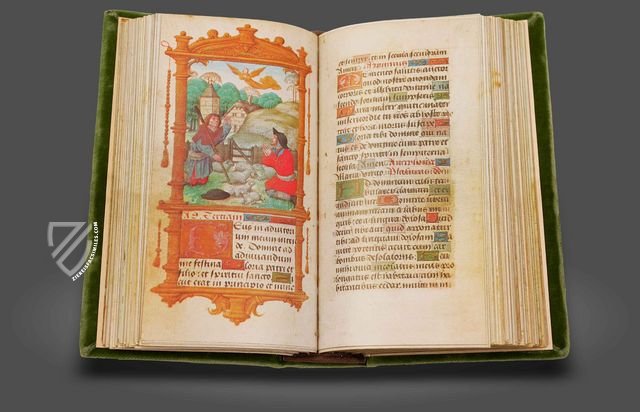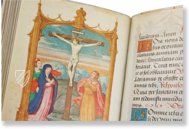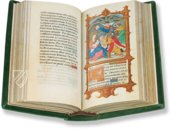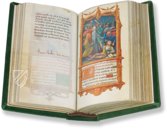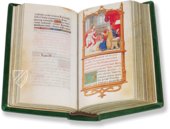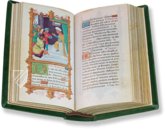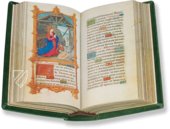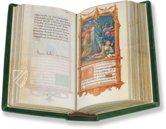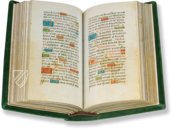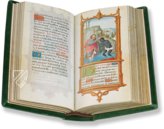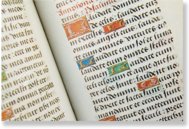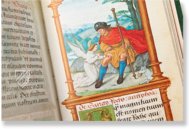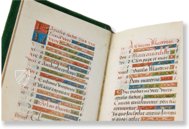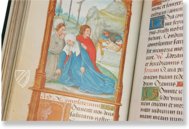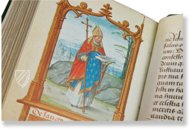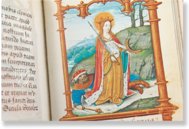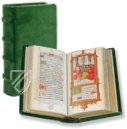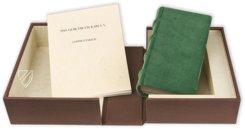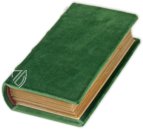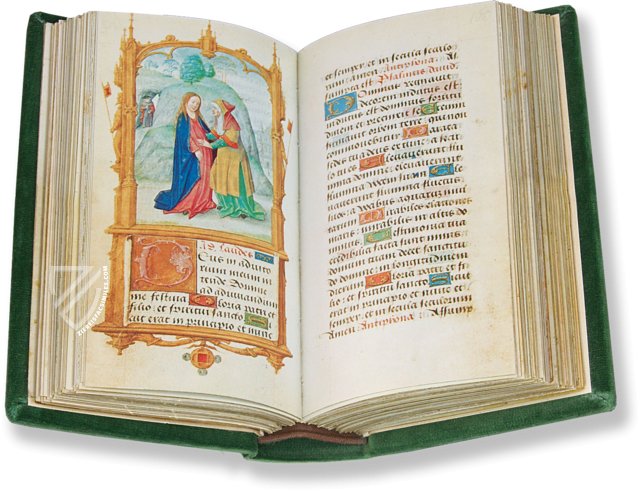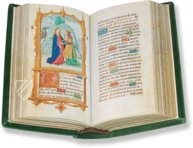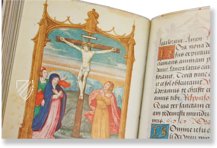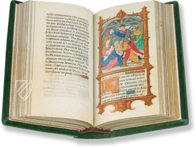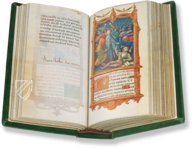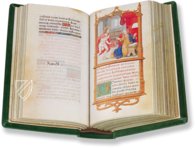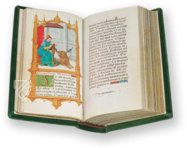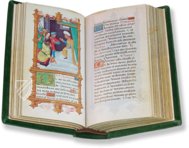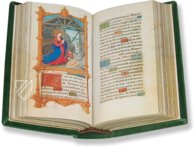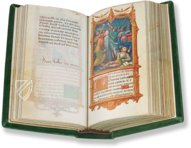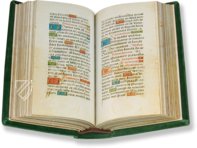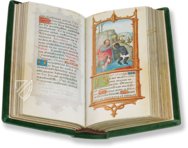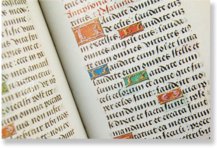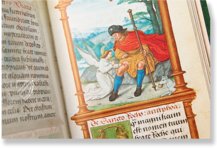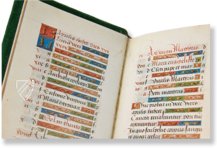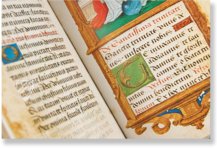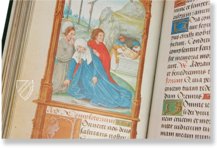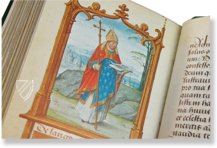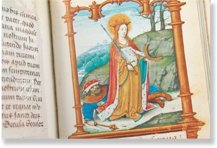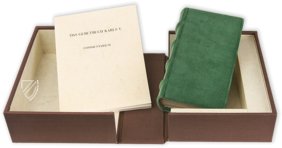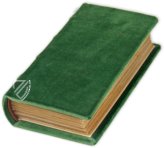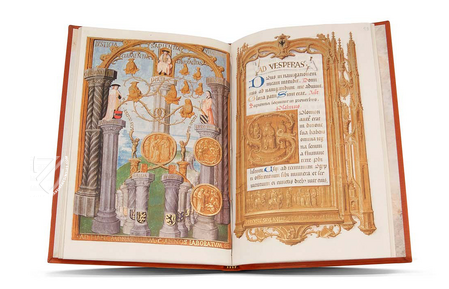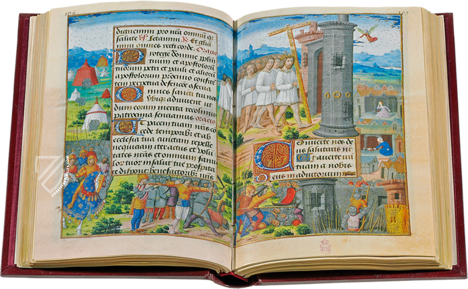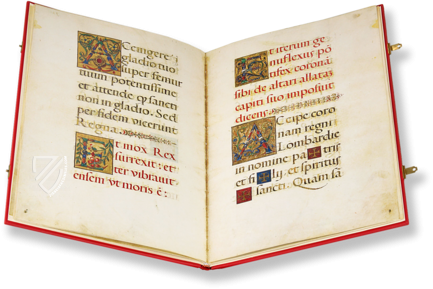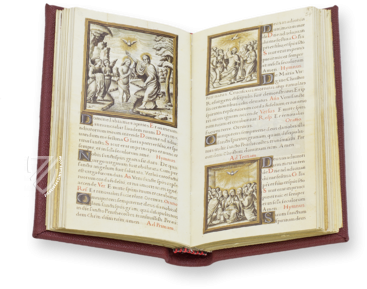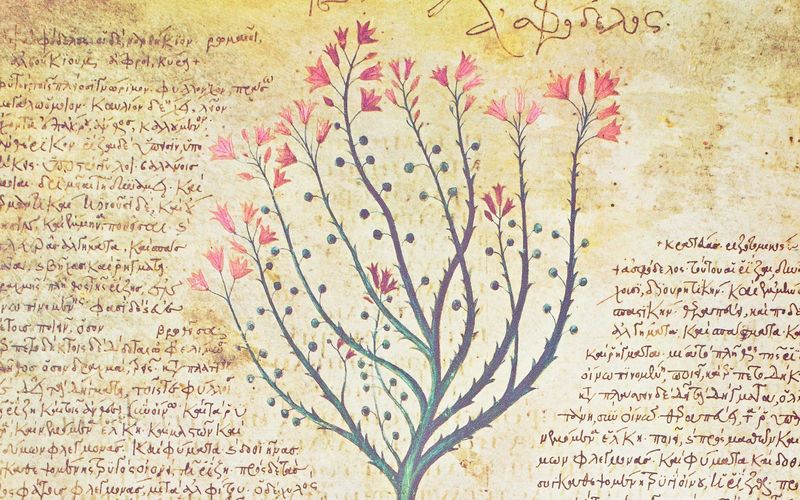Older Prayerbook of Emperor Charles V
(under 1,000€)
The Older Prayer Book of Emperor Charles V is a livres d'heures that belongs to the last generation of this type of book and distinguishes itself in several ways. The artistry of the codex is a mix of elaborate artistry and subdued, simple decoration intended not to distract the faithful from the content of the text. The personal religiosity of the emperor is reflected in the numerous signs of use throughout the text. That being said, many of its features can be considered to be artistically perfect, including the details of peoples' garments and the landscapes in the backgrounds. The design of the manuscript indicates a purposeful restraint intended to curtail any unnecessary pomp, and that this manuscript was intended primarily for religious edification, not as an artistic display of wealth and sophistication. A truly wonderful testimony to Charles V's spirituality.
Older Prayerbook of Emperor Charles V
In the years from 1516 to 1519, when young Charles was King of Spain but before his imperial coronation, he was given a prayer book that he was to use with great zeal, judging by the wear and tear still visible today. The outstandingly beautiful decoration of the Older Prayerbook of Emperor Charles V is worthy of a sovereign who was to become the famous emperor in whose realm the sun never set. The artistic decoration consists of 76 miniatures whose format is essentially defined by the frame, additional borders enriched with graphical ornament, colorful initials dispersed throughout the text, as well as line endings on the painted pages matching the color of the frames. The 24 calendar pages introducing the text are decorated throughout with initials, ornamental borders, and alternating red and black script, all constituting elaborate works of art in their own right, even without figural decoration. The artist, however, avoided opulent splendor, which might have prevented the devout from concentrating on the contents of the book. On the contrary, the ascetic simplicity of the frames further enhances the organic unity of text and decoration, making the book not only a precious showpiece but also an object of devotion much used by the young king and eventual emperor.
The Artistic Furnishings
Although the prayer book is in line with the well-established tradition of the livres d’heures, its individual layout and decorative concept still differ from other numerous examples of this genre. It belongs to the last generation of this type of book which flourished up to the second decade of the 16th century, but start declining in the third. Rather than representing a transitional phase, it marks the finale of a great tradition. The invaluable miniatures are the work of an anonymous master. An important feature is the delicate color palette whose beauty defines the artistic effect of this book, lending the landscapes in the background a soft, vaporous tone, and skimming the details. While the artist masters landscape perspectives with great perfection, the architectural elements in the foreground remain rather simple and plain. The painter particularly enjoys representing fashion details, especially of female clothing. The Elder Prayer Book of Charles V has opted for simple but effectual framing without exaggerating pomp. Moreover, the initials deserve particular mention as ornamental elements. They are the work of one master who created them in close co-operation with the scribe and the miniaturist. He also made the numerous line endings with delicate multi-color ornamental bands conferring a joyful, colorful aspect especially to the pages of the calendar.
A Priceless Jewel for Pious Devotion
The book is written in Latin, a language comprehensible to any educated person of this period. Only a small number of prayers, some rubrics, and inserted instructions, are in French. The codex was written by a single hand following a specially devised plan, in a very diligent and delicate Burgundian bastarda. The noble simplicity of the script befits this precious object of private devotion. The outstanding value of this small format prayer book is further demonstrated by the use of the finest virgin vellum. The royal owner and zealous user of the manuscript, Charles V, is depicted on fol. 213v. On this page as well as the following one (fol. 214r), which represents the prayer to his own guardian angel, the text is nearly illegible due to soiling through excessive use. This prayer book, whose outward form reflects the dignity of its royal owner, served as a book of edification for the young sovereign who often sat with it in devotion and meditation.
The Commentary Volume
The comprehensive scholarly commentary was written by Heinrich Karl von Liechtenstein and provides a codicological and art historical introduction to the Elder Prayer Book of Charles V. Furthermore, it deals with the textual contents of the book in a comprehensible way and describes the decorative apparatus with numerous comparative figures.
Codicology
- Alternative Titles
- Das ältere Gebetbuch Kaiser Karls V.
Älteres Gebetbuch Kaiser Karls V.
First Prayer Book of Charles V - Size / Format
- 512 pages / 15.3 × 8.3 cm
- Origin
- Belgium
- Date
- 1516–1519
- Epochs
- Style
- Genre
- Script
- Littera bastarda
- Illustrations
- 76 miniatures from the Gent-Bruges School and numerous colored initials
- Content
- Liturgy of the Hours
- Previous Owners
- Emperor Charles V (1500–58)
Older Prayerbook of Emperor Charles V
The Veil of Veronica
According to legend, St. Veronica encountered Jesus on his way to Calvary and wiped the blood and sweat from his face with her veil, which became one of the most venerated relics during the Middle Ages. Christ’s face is shown as though it were a portrait looking directly out at the beholder, including details of his hair and the blood on his brow. Veronica is dressed in the fashion of the 16th century: a stylish hat, flowing dress, and tailored blouse with puffy sleeves.

Older Prayer Book of Emperor Charles V
Coronation of the Virgin
This scene is usually presented as the final episode in the Life of the Virgin and follows her Assumption. The title Regina Coeli or “Queen of Heaven” first appeared in the 12th century and this artistic theme first appeared in an English tympanum around that time. By the 16th century, it had an established iconography.
Presented in an elegant architectural frame, the typical characters are present here: God the Father, Christ the Son, and the Holy Spirit in the form of a dove. However, this depiction of the Virgin Mary’s coronation is unusual because God the Father is usually depicted as older and wearing a Papal tiara, but both figures appear identical in dress and appearance here – a suggestion about the nature of the Trinity perhaps?
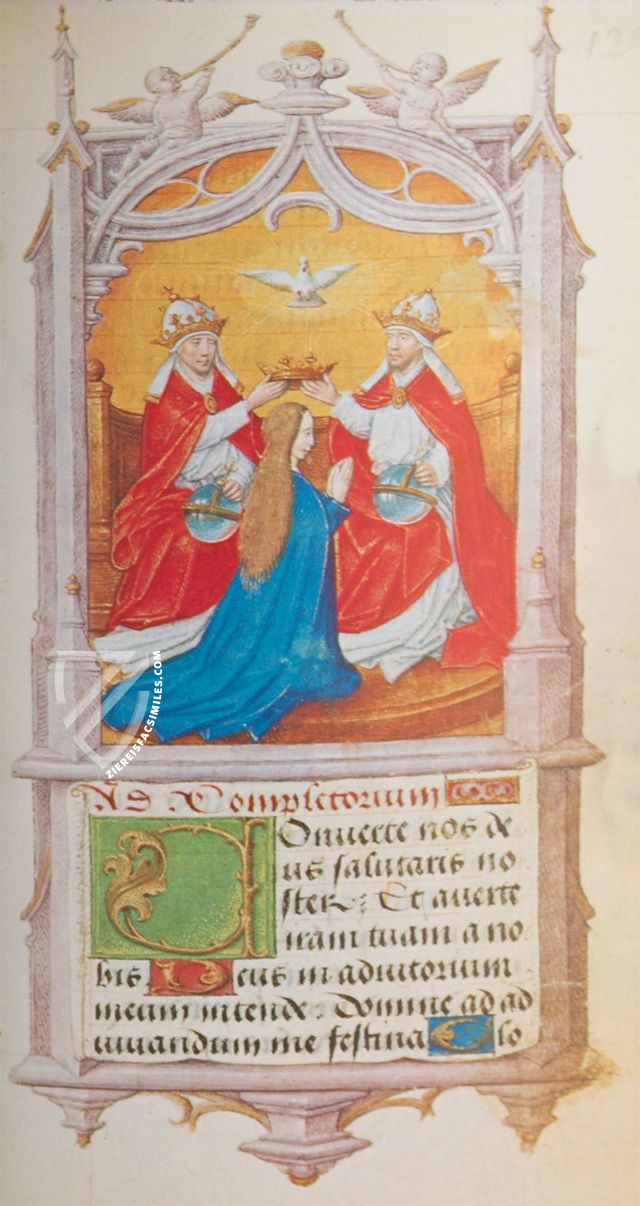
#1 Das ältere Gebetbuch Kaiser Karls V
Language: German
(under 1,000€)
- Treatises / Secular Books
- Apocalypses / Beatus
- Astronomy / Astrology
- Bestiaries
- Bibles / Gospels
- Chronicles / History / Law
- Geography / Maps
- Saints' Lives
- Islam / Oriental
- Judaism / Hebrew
- Single Leaf Collections
- Leonardo da Vinci
- Literature / Poetry
- Liturgical Manuscripts
- Medicine / Botany / Alchemy
- Music
- Mythology / Prophecies
- Psalters
- Other Religious Books
- Games / Hunting
- Private Devotion Books
- Other Genres
- Afghanistan
- Armenia
- Austria
- Belgium
- Belize
- Bosnia and Herzegovina
- China
- Colombia
- Costa Rica
- Croatia
- Cyprus
- Czech Republic
- Denmark
- Egypt
- El Salvador
- Ethiopia
- France
- Germany
- Greece
- Guatemala
- Honduras
- Hungary
- India
- Iran
- Iraq
- Israel
- Italy
- Japan
- Jordan
- Kazakhstan
- Kyrgyzstan
- Lebanon
- Liechtenstein
- Luxembourg
- Mexico
- Morocco
- Netherlands
- Palestine
- Panama
- Peru
- Poland
- Portugal
- Romania
- Russia
- Serbia
- Spain
- Sri Lanka
- Sweden
- Switzerland
- Syria
- Tajikistan
- Turkey
- Turkmenistan
- Ukraine
- United Kingdom
- United States
- Uzbekistan
- Vatican City
- A. Oosthoek, van Holkema & Warendorf
- Aboca Museum
- Ajuntament de Valencia
- Akademie Verlag
- Akademische Druck- u. Verlagsanstalt (ADEVA)
- Aldo Ausilio Editore - Bottega d’Erasmo
- Alecto Historical Editions
- Alkuin Verlag
- Almqvist & Wiksell
- Amilcare Pizzi
- Andreas & Andreas Verlagsbuchhandlung
- Archa 90
- Archiv Verlag
- Archivi Edizioni
- Arnold Verlag
- ARS
- Ars Magna
- ArtCodex
- AyN Ediciones
- Azimuth Editions
- Badenia Verlag
- Bärenreiter-Verlag
- Belser Verlag
- Belser Verlag / WK Wertkontor
- Benziger Verlag
- Bernardinum Wydawnictwo
- BiblioGemma
- Biblioteca Apostolica Vaticana (Vaticanstadt, Vaticanstadt)
- Bibliotheca Palatina Faksimile Verlag
- Bibliotheca Rara
- Boydell & Brewer
- Bramante Edizioni
- Bredius Genootschap
- Brepols Publishers
- British Library
- C. Weckesser
- Caixa Catalunya
- Canesi
- CAPSA, Ars Scriptoria
- Caratzas Brothers, Publishers
- Carus Verlag
- Casamassima Libri
- Centrum Cartographie Verlag GmbH
- Chavane Verlag
- Christian Brandstätter Verlag
- Circulo Cientifico
- Club Bibliófilo Versol
- Club du Livre
- CM Editores
- Collegium Graphicum
- Collezione Apocrifa Da Vinci
- Comissão Nacional para as Comemorações dos Descobrimentos Portugueses
- Coron Verlag
- Corvina
- CTHS
- D. S. Brewer
- Damon
- De Agostini/UTET
- De Nederlandsche Boekhandel
- De Schutter
- Deuschle & Stemmle
- Deutscher Verlag für Kunstwissenschaft
- DIAMM
- Droz
- E. Schreiber Graphische Kunstanstalten
- Ediciones Boreal
- Ediciones Grial
- Ediclube
- Edições Inapa
- Edilan
- Editalia
- Edition Deuschle
- Edition Georg Popp
- Edition Leipzig
- Edition Libri Illustri
- Editiones Reales Sitios S. L.
- Éditions de l'Oiseau Lyre
- Editions Medicina Rara
- Editorial Casariego
- Editorial Mintzoa
- Editrice Antenore
- Editrice Velar
- Edizioni Edison
- Egeria, S.L.
- Eikon Editores
- Electa
- Emery Walker Limited
- Enciclopèdia Catalana
- Eos-Verlag
- Ephesus Publishing
- Ernst Battenberg
- Eugrammia Press
- Extraordinary Editions
- Fackelverlag
- Facsimila Art & Edition
- Facsimile Editions Ltd.
- Facsimilia Art & Edition Ebert KG
- Faksimile Verlag
- Feuermann Verlag
- Folger Shakespeare Library
- Franco Cosimo Panini Editore
- Friedrich Wittig Verlag
- Fundación Hullera Vasco-Leonesa
- G. Braziller
- Gabriele Mazzotta Editore
- Gebr. Mann Verlag
- Gesellschaft für graphische Industrie
- Getty Research Institute
- Giovanni Domenico de Rossi
- Giunti Editore
- Graffiti
- Grafica European Center of Fine Arts
- Guido Pressler
- Guillermo Blazquez
- Gustav Kiepenheuer
- H. N. Abrams
- Harrassowitz
- Harvard University Press
- Helikon
- Hendrickson Publishers
- Henning Oppermann
- Herder Verlag
- Hes & De Graaf Publishers
- Hoepli
- Holbein-Verlag
- Houghton Library
- Hugo Schmidt Verlag
- Idion Verlag
- Il Bulino, edizioni d'arte
- ILte
- Imago
- Insel Verlag
- Insel-Verlag Anton Kippenberger
- Instituto de Estudios Altoaragoneses
- Instituto Nacional de Antropología e Historia
- Introligatornia Budnik Jerzy
- Istituto dell'Enciclopedia Italiana - Treccani
- Istituto Ellenico di Studi Bizantini e Postbizantini
- Istituto Geografico De Agostini
- Istituto Poligrafico e Zecca dello Stato
- Italarte Art Establishments
- Jan Thorbecke Verlag
- Johnson Reprint Corporation
- Josef Stocker
- Josef Stocker-Schmid
- Jugoslavija
- Karl W. Hiersemann
- Kasper Straube
- Kaydeda Ediciones
- Kindler Verlag / Coron Verlag
- Kodansha International Ltd.
- Konrad Kölbl Verlag
- Kurt Wolff Verlag
- La Liberia dello Stato
- La Linea Editrice
- La Meta Editore
- Lambert Schneider
- Landeskreditbank Baden-Württemberg
- Leo S. Olschki
- Les Incunables
- Liber Artis
- Library of Congress
- Libreria Musicale Italiana
- Lichtdruck
- Lito Immagine Editore
- Lumen Artis
- Lund Humphries
- M. Moleiro Editor
- Maison des Sciences de l'homme et de la société de Poitiers
- Manuscriptum
- Martinus Nijhoff
- Maruzen-Yushodo Co. Ltd.
- MASA
- Massada Publishers
- McGraw-Hill
- Metropolitan Museum of Art
- Militos
- Millennium Liber
- Müller & Schindler
- Nahar - Stavit
- Nahar and Steimatzky
- National Library of Wales
- Neri Pozza
- Nova Charta
- Oceanum Verlag
- Odeon
- Orbis Mediaevalis
- Orbis Pictus
- Österreichische Staatsdruckerei
- Oxford University Press
- Pageant Books
- Parzellers Buchverlag
- Patrimonio Ediciones
- Pattloch Verlag
- PIAF
- Pieper Verlag
- Plon-Nourrit et cie
- Poligrafiche Bolis
- Presses Universitaires de Strasbourg
- Prestel Verlag
- Princeton University Press
- Prisma Verlag
- Priuli & Verlucca, editori
- Pro Sport Verlag
- Propyläen Verlag
- Pytheas Books
- Quaternio Verlag Luzern
- Reales Sitios
- Recht-Verlag
- Reichert Verlag
- Reichsdruckerei
- Reprint Verlag
- Riehn & Reusch
- Roberto Vattori Editore
- Rosenkilde and Bagger
- Roxburghe Club
- Salerno Editrice
- Saltellus Press
- Sandoz
- Sarajevo Svjetlost
- Schöck ArtPrint Kft.
- Schulsinger Brothers
- Scolar Press
- Scrinium
- Scripta Maneant
- Scriptorium
- Shazar
- Siloé, arte y bibliofilia
- SISMEL - Edizioni del Galluzzo
- Sociedad Mexicana de Antropología
- Société des Bibliophiles & Iconophiles de Belgique
- Soncin Publishing
- Sorli Ediciones
- Stainer and Bell
- Studer
- Styria Verlag
- Sumptibus Pragopress
- Szegedi Tudomànyegyetem
- Taberna Libraria
- Tarshish Books
- Taschen
- Tempus Libri
- Testimonio Compañía Editorial
- Thames and Hudson
- The Clear Vue Publishing Partnership Limited
- The Facsimile Codex
- The Folio Society
- The Marquess of Normanby
- The Richard III and Yorkist History Trust
- Tip.Le.Co
- TouchArt
- TREC Publishing House
- TRI Publishing Co.
- Trident Editore
- Tuliba Collection
- Typis Regiae Officinae Polygraphicae
- Union Verlag Berlin
- Universidad de Granada
- University of California Press
- University of Chicago Press
- Urs Graf
- Vallecchi
- Van Wijnen
- VCH, Acta Humaniora
- VDI Verlag
- VEB Deutscher Verlag für Musik
- Verlag Anton Pustet / Andreas Verlag
- Verlag Bibliophile Drucke Josef Stocker
- Verlag der Münchner Drucke
- Verlag für Regionalgeschichte
- Verlag Styria
- Vicent Garcia Editores
- W. Turnowski Ltd.
- W. Turnowsky
- Waanders Printers
- Wiener Mechitharisten-Congregation (Wien, Österreich)
- Wissenschaftliche Buchgesellschaft
- Wissenschaftliche Verlagsgesellschaft
- Wydawnictwo Dolnoslaskie
- Xuntanza Editorial
- Zakład Narodowy
- Zollikofer AG

